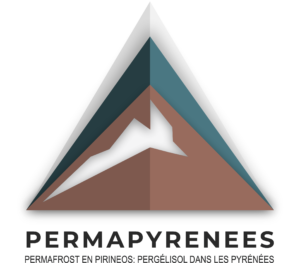Projects
PRESENT PROJECTS
PERMAFROST ALS PIRINEUS: LA MUNTANYA CANVIANT
Els Pirineus són la cadena muntanyenca del sud d'Europa on la criosfera té un paper crucial en els processos hidrològics, geomorfològics i ambientals. Els components de la criosfera (neu, glacials i permafrost)serveixen com a indicadors sòlids del canvi climàtic i al mateix temps són perceptibles per a la societat. El recent canvi climàtic ha provocat una reducció de la capa de neu i la imminent desaparició de les glaceres pirinenques; tot això s'està supervisant a través de diferents projectes i iniciatives transpirinenques.
No obstant això, encara avui se sap molt poc sobre el permafrost (sòl permanentment congelat), més enllà de la seva existència en les zones més altes de la serralada (>2.600 m). Se sap encara menys sobre la seva dinàmica recent i com pot respondre a l'augment tèrmic projectat en el futur.


Permapyrenees (EFA 063/01) és un projecte Interreg POCTEFA, de 3 anys de durada (01/01/2024 - 01/01/2027) i Co Finançat per la Unió Europea que es basa en l'estudi del permafrost, i generarà nous indicadors per al seguiment del canvi climàtic. Aquest projecte, a més, servirà per a vigilar i prevenir els riscos derivats de la degradació del permafrost (p. ex., inestabilitat de vessants o despreniments de roques), que en els últims anys han afectat rutes de muntanya molt freqüentades i a algunes infraestructures. Per a això, s'utilitzaran una sèrie de tècniques noves de monitoratge i una sèrie de perforacions en profunditat per a detectar la presència de permafrost i els riscos associats a la seva existència. A més, la precisa informació generada en aquest projecte serà compartida amb els agents gestors del territori així com amb la població en general afí a practicar i gaudir de la muntanya amb més seguretat. Aquestes perforacions es realitzaran en les següents zones;
- Besiberri (GR Besiberri N 2600m)
- Circ de Pessons (GR Clot de la Menera 2492m)
- Vignemale (Col de la Cerbillona 3198m)
- Ardiden (GR Ardiden - Lac Grand 2460m)
- Monte Perdido ( Pic Marboré 3251m)
- Pica d’Estats (GR Clot de Broate 2800m)
- Pica d’Estats (Montcalm 3078m)
- Maladeta (Pico de Coronas 3297m).
En aquest projecte participen com a socis col·laboradors Andorra Recerca Innovació; Centre for Studies and Expertise on Risks, the Environment, Mobility and Urban Planning (CEREMA); Centre Tecnològic de Telecomunicacions de Catalunya (CTTC); Instituto Pirenaico de Ecología (IPE-CSIC); Kilian Jornet Foundation (KJF); Universitat de Barcelona (UB); Université de Perpignan Via Domitia (UPVD).
I com a associats les següents entitats; Environnements, Dynamiques et Territoires de Montagne (EDYTEM); Grupo de Investigación en Geografía Física de Alta Montaña (GFAM); Ordesa - Viñamala Reserva de la Biosfera; PANGEA; Parc Nacional d’Aigües Tortes i Estany de Sant Maurici; Parc Natural de l’ Alt Pirineu; Servei Meteorològic de Catalunya.
Reconstruction of Neoglacial oscillations in Greenland. (NEOGREEN)
The Greenland Ice Sheet (GrIS) is considered a sentinel of climate change and is showing signals of accelerated readjustment to the changing climatic setting. Rising temperatures favour the retreat of polar ice sheets, which are melting at unparalleled rates since, at least, the satellite era and affect the entire Earth through a wide range of feedback processes and climate teleconnection patterns. However, we still do not know wether current glacial shrinking is unprecedented in the recent geological record.
Within this context, NEOGREEN will focus on two ice-free areas in W Greenland that can provide key data on the spatial-temporal pattern of glacial advances and retreats since the onset of the Neoglacial (last 4 ka): the western margins of the GrIS and a peripheral ice-cap. Here, there are widespread glacial records including moraines, polished surfaces and erratic boulders that can be used to reconstruct past glacial phases. With this purpose, at each site we will apply a multiple-dating approach combining absolute (cosmic-ray exposure, lichenometry, OSL) and relative dating techniques (Schmidt hammer). We will compare our outputs on past glacial dynamics with available satellite and aerial imagery, old pictures and glaciological data in order to infer if the recent glacial retreat in W Greenland constitutes an amplified response of the ongoing climate change in the High Arctic or it fits within the natural climate variability in the region. Recent landscape changes in newly exposed terrain following glacial retreat will be also examined using remote sensing analysis and field evidence in order to unveil the role of climate and time on vegetation colonization and soil formation. This can provide insights about the potential response of ecosystems in a future warmer Greenland.
With these objectives, we will combine cutting-edge field technologies, analytical methodologies and statistical techniques performing six main tasks:
- Geomorphological mapping
- Field work activities
- Laboratory analyses
- Reconstruction of glacial oscillations
- Reconstruction of climate variability
- Recent geoecological dynamic
The project NEOGREEN will be coordinated from the Department of Geography of the University of Barcelona. It will count with a strong multidisciplinary and international team of leading experts that will provide expertise and equipment for the project purposes. The team integrates researchers from Spain, Portugal, France and United Kingdom, who have decades of research experience in the Polar Regions.
The complex field facilities will be arranged by an experienced Greenlandic agency, which will provide access and logistic support. The scientific dissemination of NEOGREEN will be done by means of publications in high-impact journals, PhD theses and presentations at conferences. Outreach activities will be also done to disseminate the importance of Arctic ecosystems beyond the academia.
Analysis of nunataks of the Antarctic Peninsula as multiproxy data sources on environmental change and climate dynamics. (NUNANTAR )
Financing entity: Fundação para a Ciência e a Tecnologia, Portugal.
REF.: 02/SAICT/2017 – 32002.
DURATION: January 1, 2019 – December 31, 2022.
PI: Dr. Marc Oliva (Universitat de Barcelona).
SUMMARY:
Present and past environmental and climatic dynamics inferred from nunataks in the Antarctic Peninsula region.
NUNANTAR brings together researchers from Spain, Portugal, France and United Kingdom with the objective of spatially and temporally reconstruct the deglaciation process at the two largest islands in the South Shetlands archipelago (Maritime Antarctica) since the Global Last Glacial Maximum. Glacier retreat in polar areas has major implications at a local, regional and even planetary scale. Global average sea level rise is the most obvious and socio-economically relevant, but there are others such as the arrival of new fauna to deglaciated areas, plant colonisation or permafrost formation and degradation. This project will study the ice-free areas in Byers and Hurd peninsulas (Livingston Island) and Fildes and Potter peninsulas (King George Island). Ice-cap glacier retreat chronology will be revealed by the use of cosmogenic isotopes (mainly 36Cl) on glacially originated sedimentary and erosive records. Cosmogenic dating will be complemented by other dating methods (C14 and OSL), which will permit the validation of these methods in regions with cold-based glaciers. Given the geomorphological evidences and the obtained ages, a deglaciation calendar will be proposed, and the glacier extension and ice thickness will be reconstructed usign a GIS methodology. The results emerging from this project will permit assess whether the high glacier retreat rates observed during the last decades were registered in the past, or they are conversely the consequence (and evidence) of the Global Change in Antarctica to generate high resolution palaeoclimate data in order to improve our understanding of the role of Antarctica and the Southern Ocean play in the global climate system during the last two millennia. Several chronological techniques will be applied, providing different types of paleoenvironmental information.
Glacial oscillations and climate variability in NE Greenland. (PALEOGREEN)
Financing entity: Ministerio de Economía y Competividad.
Ref.: CTM2017-87976-P
DURATION: January 1, 2018 -December 31, 2022.
PI: Dr. Marc Oliva (Universitat de Barcelona).
SUMMARY:
The High Arctic has been among the fastest warming regions on Earth during the last decades. In Greenland, such warming is having important implications on glacier mass balances and driving substantial geoecological changes in ice-free areas, but many effects are yet not understood. Glaciers and permafrost-related features are among those expected to show the most dramatic local responses to changing climate in Greenland. The consequences of this warming trend on polar terrestrial and marine ecosystems may also affect the entire Earth through a wide range of feed-back processes and climate teleconnection patterns.
Within this context, PALEOGREEN will focus on Zackenberg area, an ice-free site located in the NE of Greenland to address two main hypotheses:
(1) Glacier thinning rates in nunataks (i.e. rocky areas surrounded by glaciers) and deglaciated coastal environments can be inferred since the onset of the deglaciation. Their comparison with recent/contemporary dynamics will allow framing recent rates of glacier shrinking with the Late Pleistocene-Holocene record.
(2) Ice-free areas include a large number of lakes in continuous permafrost terrain. A high-resolution geochemical, biological and physical characterization of the properties of sediment cores from some of these lakes will provide the climatic background driving glacial oscillations since their deglaciation.
We will apply a multiple-dating approach combining absolute (cosmogenic, lichenometry, OSL, 14C) and relative dating techniques (Schmidt hammer, Equotip) at each site to reconstruct the spatio-temporal patterns of glacial advances and retreats since the onset of the deglaciation. The analysis of remote sensing and aerial imagery, old pictures and glaciological data, will elucidate whether the recent glacial retreat in NE Greenland is part of natural climate variability or it results of the amplification of the feedback effects of climate change in the High Arctic.
The multidisciplinary team of PALEOGREEN will address the two hypotheses completing five tasks carried out using cutting-edge field technologies, analytical methodologies and statistical techniques:
Task 1 – Remote sensing mapping
Task 2 – Field work activities
Task 3 – Laboratory analyses
Task 4 – Reconstruction of the deglaciation
Task 5 – Reconstruction of climate variability
PALEOGREEN will be coordinated from the Department of Geography of the University of Barcelona (UB). The project integrates a strong multidisciplinary team of national and international researchers that will provide expertise and equipment for the project purposes. The team includes scientists from Spain, Portugal, France and Canada, who will collectively draw on decades of research experience in Polar Regions. Logistics of the project is ensured by field support of EU-PolarNet facilities. We will continue to present our results at international conferences, publish in high-impact journals and disseminate on the importance of Arctic research through education and outreach activities.
PAST PROJECTS
Glacial oscillations NE Greenland. INTERACT Transnational Access. (GLACIGREEN)
Funded by: European Union’s Horizon 2020 researchprogramme.
Ref.: 730938
Duration: 2018-2019
PI: Dr. Marc Oliva (Universitat de Barcelona).
SUMMARY:
The High Arctic has been among the fastest warming regions on Earth during the last decades. In Greenland, such warming is having important implications on glacier mass balances and driving substantial geoecological changes in ice-free areas, but many effects are yet not understood. Glaciers and permafrost-related features are among those expected to show the most dramatic local responses to changing climate in Greenland. The consequences of this warming trend on polar terrestrial and marine ecosystems may also affect the entire Earth through a wide range of feed-back processes and climate teleconnection patterns.



